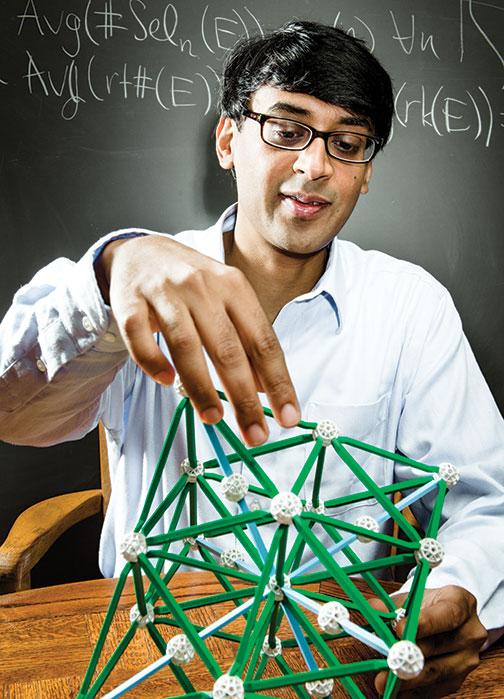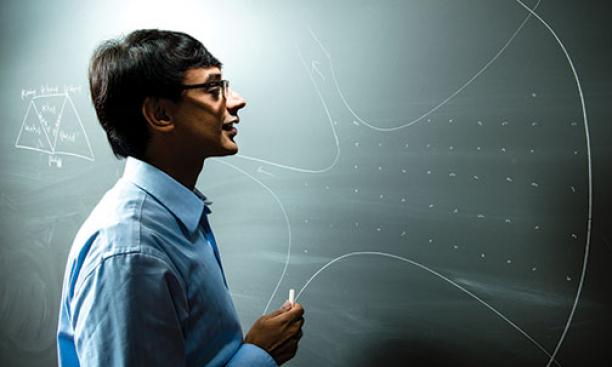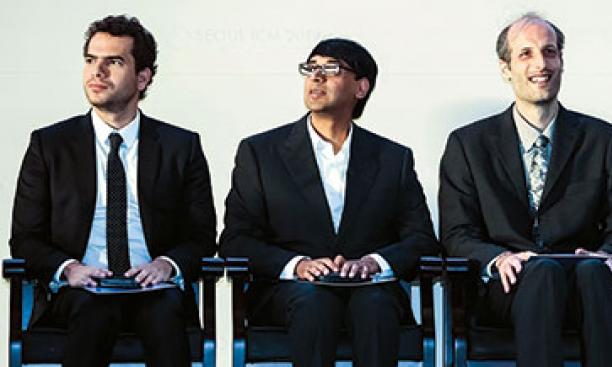
The great mathematicians find inspiration in unexpected places. Archimedes had his overflowing bathtub, Newton a falling apple.
For Princeton mathematics professor Manjul Bhargava *01, it was a Rubik’s Cube that provided the crucial flash of insight, allowing him to revolutionize an area of number theory called Gauss composition. Named for the great 19th-century mathematician Carl Friedrich Gauss, Gauss composition asks under what general conditions two quadratic expressions (such as a2 + b2) can be added together to produce a third. That work led directly to Bhargava’s PhD. dissertation, “Higher Composition Laws,” then to a flood of international math prizes, and finally, in August, to his becoming the latest Princetonian to win the coveted Fields Medal, often referred to as the Nobel Prize of mathematics.
“It wasn’t anything I was trying to solve,” says Bhargava of his groundbreaking work. “It often happens with me: I don’t know what problem I’m trying to solve; I’m just playing around. The problem I’m trying to solve emerges only later.”
Just playing around: It’s been that way since Bhargava was a small boy growing up on Long Island. He was full of mischievous energy; to calm him down, his mother would give him math problems to solve in his head. “He had his own mysterious way of figuring these things out,” says Mira Bhargava. “He’d use his fingers, flicking them back and forth to get the correct answers.” But when she asked him to explain what he was doing, he either wouldn’t or couldn’t. “I think it was too intuitive for him to explain,” she says.
He was not home-schooled so much as self-schooled. When he didn’t feel like going to school, he’d stay home and read or beg his mother to take him along to the math classes she taught at Hofstra University in New York. How the Hofstra students howled when their 8-year-old visitor corrected their professor!
He was staggeringly precocious. How many of us can say that we first became familiar with the 7th-century Indian mathematician Brahmagupta when we were children “because most of his writings are in Sanskrit”? At an age when other boys were computing batting averages, Bhargava was searching for a formula to compute the number of oranges he saw stacked in pyramids in the kitchen or drawing up lists of prime numbers, hoping to discover a pattern. As a tiny boy, he could pop geometrically shaped blocks through corresponding holes cut in the side of a toy box so fast that watching him became a spectator sport for the adults.
“None of us could do it in three times the time,” marvels Mira.
“I suspect I had a lot more practice than they did,” says her son.
He loved his regular boyhood visits to the ancient family seat in Jaipur, the fabled “Pink City” of northwestern India. “The homes are open, so you’re basically outside all the time,” says Bhargava, adding that his experiences there turned him into a committed environmentalist. “And it’s not just humans: There were monkeys and peacocks coming down to land on the roof.”
He took long, early-morning walks with his maternal grandfather, Purushottam Lal Bhargava, a renowned scholar of Sanskrit and Indian culture and history. The two would talk about India and poetry and “even some math,” recalls Bhargava fondly. The elder Bhargava died a few years ago, but his deep love of India lives on in his grandson. Bhargava is a practicing Hindu, though more for ethical reasons than doctrinal ones. He uses the 10 tenets of Hinduism as a life guide. “If everyone followed these, the world would be a better place,” he says.
By the end of ninth grade, he had completed all of the math and computer courses at his high school and had begun working his way through courses at Hofstra. Chosen to be valedictorian of his high school class, he nearly lost that honor when a health teacher objected to his spotty attendance record. But the school was proud to finally have a non-athlete accepted to Harvard, so the picky teacher was overruled — and Bhargava went off to Cambridge.
Mira Bhargava insists that her son’s upbringing wasn’t all that unusual, and Bhargava shrugs off any suggestion that it was difficult to be such a prodigy. He would join the other children riding bikes and playing kickball. His training took place so far off the grid that, when he got to Harvard, he was an unknown quantity in the math department. All the other math hotshots knew each other, having competed in math Olympiads. Not Bhargava, who had learned his trade on his own. Still, he quickly showed that he was every bit as talented as anyone there. He was a teaching assistant instructing fellow undergrads, and three times received the Derek Bok Award for Excellence in Teaching. He would graduate second in his class and serve as salutatorian. He also won the Morgan Prize for outstanding mathematical research by an undergraduate attending any North American university.
He came to Princeton for his Ph.D., where he worked with the great number theorist Andrew Wiles, who in 1993 had made headlines around the world for his proof of Fermat’s Last Theorem, solving a mathematical mystery that had stood since 1637. From the day he arrived at Princeton, Bhargava stood out. “It was obvious to everyone that he had a chance of winning the Fields Medal one day,” says Charles Fefferman *69, the Herbert Jones Professor of Mathematics at Princeton and a Fields medalist himself.
Bhargava would get tenure at age 28, a remarkably young age in a department that usually hires established mathematicians to its faculty. “He was barely older than us, it felt like,” says Melanie Wood *09, who was one of his first two graduate students and is now a math professor at the University of Wisconsin.

Today, sitting in his office high in Fine Hall, Bhargava, 40, looks a good 10 years younger than his age. He is wearing a rust-colored Hawaiian shirt and is surrounded by various math-related toys and games. There are a variety of Rubik’s Cubes, decks of cards, brightly colored skeletal Zometool products (the company website announces: “Loved by kids, used by Nobel Prize winners”), and a 1,000-piece three-dimensional jigsaw puzzle of the Taj Mahal. They reflect the wide range of his interests, though most have numbers as their basis.
“A lot of high-powered mathematicians are very forbidding,” says Lenhard Ng, a close friend from undergraduate days at Harvard who’s now a math professor at Duke. “Not Manjul. He’s incredibly generous with his time. He’ll talk math with everybody.” Not only will he talk math, he has a knack for making it comprehensible — or at least as comprehensible as these esoteric subjects ever are. Like many mathematicians, Bhargava feels that his beloved subject is taught poorly at every level, giving students no chance to appreciate its beauty. He’d like to change that. He lectures to general audiences, has spoken about trying to open a chain of math schools in India, and at Princeton created a freshman seminar on “The Mathematics of Magic Tricks and Games” and a course, “The Magic of Numbers,” aimed at humanities students. The latter course explores the math behind things we know from everyday life: M.C. Escher drawings, musical rhythms, games of chance, and mathematical designs in nature.
“One thing that really makes him stand out is his commitment to explaining his work,” says Wood. “Generally, when someone is doing incredibly good math and proving important results, they’re excused a little bit from explaining them very well; it’s assumed that other people will do it for you. Manjul, on the other hand, is eager to explain what he’s doing.”
Bhargava works in one of the oldest and most revered areas of math: number theory, the study of whole numbers and their relationship to each other. “It’s sort of audacious to work in number theory because it’s a subject that’s been around for so long you feel that everything should be known by now,” muses Ng. “Manjul manages to solve problems that could have been solved hundreds of years ago but were not.”
Wood says: “The questions that are left are really, really hard.”
That was true, certainly, of Bhargava’s work on Gauss composition. Along with the likes of Newton and Archimedes, Gauss was one of math’s titans. His first blockbuster was Disquisitiones Arithmeticae, which still is regarded as a classic of number theory. Written in Latin and published in 1801, when Gauss was only 24, one of its highlights was something called the composition of quadratic binary forms, which fascinated Bhargava. So, late one night, while contemplating a “Pocket Cube” — a Rubik’s Cube made of eight pieces, all corners — in his room at the Graduate College, he wondered whether its 2 x 2 x 2 structure might reveal something about Gauss composition. He numbered all eight blocks and began manipulating the cube.
“By thinking about this little toy, Manjul discovered a better way of doing something that is the highlight of the great masterpiece of one of the giants of mathematics,” marvels Fefferman. Whereas the great Gauss had produced a single higher-composition law — and needed some 20 pages to describe it — Bhargava would discover a dozen more. “Manjul figured out that Gauss’ way of composing binary quadratic forms was much too complicated and could be done in many fewer steps,” says Fefferman. “Furthermore, Gauss discovered only one of 13 variants. The rest are due to Manjul.”
Elegance and simplicity are two of the highest goals of all mathematical expression. “A not-so-elegant proof would be like a corn maze, where you can’t see where you’re going,” explains Wood. “An elegant proof is like a road where you can see where you’re going.” Ng says: “When he explains his work to you, it seems like it’s obvious. And you think, ‘Oh well, there can’t be much to it because it’s so obvious.’ Then you realize that it’s actually very profound. There are problems that people have been working on for hundreds of years and have made no progress. Manjul somehow managed to see something no one else could.”

More recently, Bhargava has resurrected something called the “geometry of numbers,” a tool developed by the German mathematician Hermann Minkowski a little more than 100 years ago. It had fallen into relative obscurity, and Wood still remembers the dismissive chuckle that greeted its mention when it came up during her departmental exams. “That’s so old,” one of the professors wisecracked. “Nobody does anything with that today.”
Here’s how it works: Picture a checkerboard with points added to the middle of each square. Next, erase the horizontal and vertical lines that make up those squares, leaving just the points. If you draw a big circle on the surface, it is not all that difficult to calculate the number of points lying within the circle: Essentially, your answer will be the area of the circle.
But if the shape is not as regular as a circle — if it’s, say, amoeba-shaped — counting those points becomes much more difficult. And what if the amoeba has weird tentacles shooting off in different directions? Things become especially tricky if the tentacles extend in many dimensions, which is how many real-world problems appear.
“That’s what a lot of my work is about,” says Bhargava, “showing that all these number-theory problems are equivalent to counting the number of grid points inside some region.” His first work on the subject was published in 2008, in a paper called “The Identity of Discriminants of Quintic Rings and Fields.” (Surely you’ve read it?) Bhargava originally saw it as a way of solving a specific problem. But, he says, “over the last six years it’s actually been applied to many, many number-theory problems. I didn’t know at the time it would be so applicable.” Applications of the geometry of numbers include cryptography, coding theory, and linear programming, which is applied everywhere in science these days. So far the specific work Bhargava has done doesn’t have any uses in the real world. But, he says, “I will not be surprised if it did eventually.”
Bhargava sees numbers everywhere, much as he did when he was a little boy counting stacks of oranges. He is an accomplished amateur magician, which explains his freshman seminar on math and magic. It seems that when magicians aren’t cutting people in half, they often are dabbling in math and using it to create tricks. “There’s a lot of deep mathematics [in magic],” says Bhargava. His students learned card and rope tricks, games with knots, and created hexaflexagons, the Venus flytrap-like “fortune-telling” contraptions children make out of paper.
Asked to perform a card trick, Bhargava chooses one called the Hummer Shuffle, which he has all the students do on the first day of class. Named for its creator, the magician Robert Hummer, it asks participants to take four cards, memorizing one that is then returned to the stack of four. After a series of as many shuffles as the participant chooses to make, the chosen card pops up every time. The math in this trick is a “fancy version of parity — that is, oddness versus evenness — but hidden in a way that even mathematicians don’t usually see it,” says Bhargava, who loves performing it. For all his modesty, he possesses just enough pride to have spent Monday mornings before class rehearsing his tricks.
READ MORE
New Book Provides a Window Into Mathematicians’ Minds
Major Trends: Math Is Hot; Decline for Social Sciences
Reading Room: Steven Strogatz ’80, The Beauty of Math
Another place where Bhargava finds deep math is in playing the tabla, the two-headed drum featured in Indian music. Tabla drumming is more improvisational than most Western drumming, partly because the music’s long measures leave more room for the drummer to improvise. Instead of containing four or eight beats, they sometimes stretch out for as many as 16 or 17 or even 48. Particularly challenging is the polyrhythmic flourish called tihai, in which the final beat of one measure must also be the first of the next.
Bhargava downplays his skills on the tabla, though others say he could easily have had a career in music. If he has a shortcoming as a player, it’s thinking so much about the math of what he’s doing. He has studied with some of the top tabla teachers in the world. They have urged him to do what must be very hard for him: to shut down the mathematical part of his brain.
When word of his winning the Fields Medal got out, congratulatory emails began to pour in, more than 3,000 of them. “I sat next to you in Mr. Scully’s class,” a childhood classmate reminded him proudly. Bhargava plans to answer them all individually. Mathematicians can’t afford to take such adulation for granted.
In Korea, where the awards ceremony was held in August as part of the International Congress of Mathematicians conference, the events were covered all day, every day, live on television. Attending at least one of the sessions were some 27,000 math fans, only 6,000 of whom were professionals. Mira was there, of course. So was Lenhard Ng. They couldn’t believe a mathematician was getting such attention.
As part of his honors, Bhargava was asked to deliver a lecture, which he did with his customary brilliance. Afterward he was mobbed by adoring fans, at one point literally pinned up against a wall. The math groupies wanted autographs and begged to take photos with him.
Still, the tribute that moved him most came from closer to home. The students in his freshman seminar, though scattered across the country for summer vacation, collaborated on a congratulatory video. Edgar von Ottenritter ’16 fashioned a tetraflexagon, which unfolded in five steps to reveal his message of congratulations. Some students performed card tricks they’d learned in class.
It was, indeed, magic.
Freelance writer Merrell Noden ’78 is a frequent PAW contributor.

